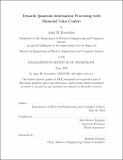Towards quantum information processing with diamond color centers
Author(s)
Karamlou, Amir H
DownloadFull printable version (2.881Mb)
Other Contributors
Massachusetts Institute of Technology. Department of Electrical Engineering and Computer Science.
Advisor
Dirk Robert Englund.
Terms of use
Metadata
Show full item recordAbstract
The DiVincenco requirements summarize the key properties that quantum systems should have to be useful for quantum computing. The work in this thesis focuses on one of the leading solid-state quantum systems, the nitrogen vacancy (NV) center in diamond. The NV has emerged as an excellent quantum sensor, in which quantum logic techniques can significantly improve performance. However, a remaining problem concerns the rate and fidelity of NV spin measurement. To address this problem in this thesis we first propose and theoretically demonstrate a scheme for spatially robust state-selective transitions with over 99.9% fidelity between different spin states in zero-field splitting. Furthermore, another central challenge tackled in this work is the efficient collection of the emitter's fluorescence. Optical antennas are appealing as they offer directional emission together with spontaneous emission rate enhancement across a broad emitter spectrum. We introduce and optimize metal-dielectric nano-antenna designs recessed into a diamond substrate and aligned with quantum emitters. We analyze trade-offs between external quantum efficiency, collection efficiency, Purcell factor, and overall collected photon rate. This analysis shows that an optimized metal-dielectric hybrid structure can increase the collected photon rate from a nitrogen vacancy center by over two orders of magnitude compared to a bare emitter. As a result, these metal-dielectric antennas should enable single-shot electron spin measurements of NV centers at room temperature.
Description
Thesis: M. Eng., Massachusetts Institute of Technology, Department of Electrical Engineering and Computer Science, 2018. This electronic version was submitted by the student author. The certified thesis is available in the Institute Archives and Special Collections. Cataloged from student-submitted PDF version of thesis. Includes bibliographical references (pages 59-63).
Date issued
2018Department
Massachusetts Institute of Technology. Department of Electrical Engineering and Computer SciencePublisher
Massachusetts Institute of Technology
Keywords
Electrical Engineering and Computer Science.